- Home
- John Berger
Photocopies: Encounters (Vintage International) Page 5
Photocopies: Encounters (Vintage International) Read online
Page 5
Photography, he once wrote in his maternal handwriting, is a spontaneous impulse which comes from perpetually looking, and which seizes the instant and its eternity.
[12]
Sheets of Paper Laid on the Grass
Many months afterwards, Marisa Camino sent me a print of the photo taken under the plum tree. Our traces remain, yet they are far less substantial than those of the tree and they are two-faced: it would be hard for a third person to decide whether we were leaving or returning, were in the process of appearing or disappearing, whether we were alive or were ghosts. With the photo was a letter and a telephone number.
And so the next summer I found myself sitting on the grass outside a small house in Galicia, about twenty kilometres from the sea. Marisa’s lightweight racing bicycle was leaning against the outside wall of the house beside the front door. The kitchen was just large enough for four of us to sit round a table and eat for supper the clams she’d cooked.
Next to the kitchen was a narrow hallway where she brought in the bicycle at night and stacked several of her larger paintings. All the ceilings of the house were covered with rolls of milkily transparent plastic which she had stapled up to prevent dust, made by woodworms, continually falling from the devoured floorboards and beams – the house was probably a century old – on to papers or food or hair.
Sitting on the grass we could hear a neighbour’s chickens and some pigeons in a pigeon loft. There were no clouds, the August sun in the west was going down very slowly and the light was diffused and vast – as though reflected by the entire Atlantic. She was taking drawings from a portfolio she had brought downstairs. The house had four rooms if you counted the bathroom. The drawings were wrapped in tissue paper like folded clothes. Methodically, one by one, she took them out of their wrapping and laid them on the grass. I pay 12,000 pesetas a month for the house, she had said.
There exist drawings which are investigative studies and others which are sketches for projected masterpieces. There are very many kinds of drawings. The ones now laid on the grass were written like letters.
The most notable collection of drawings of this kind – drawings written like letters – is to be found in the Kunstmuseum in Bern and they were made by Paul Klee between the years 1927 and 1940. (The years of my childhood; it was in 1940, the year of his death, that I first saw a painting by Klee reproduced.) They talk, these pencil drawings by Klee, of, amongst other things, the rise of fascism, his loves, his health and his foretold death. They are like letters because you have the feeling that they have been drawn without once looking up, and that the trusted one to whom they are addressed resides in the paper itself.
Behind the kitchen there is a kind of dark annexe – maybe, originally, chickens were shut in there at night – and this is where Marisa makes her paper. She makes it from straw which she soaks in water, lets ferment and then presses out. The paper is camel-coloured (she says ‘rabbit-coloured’), full of fibres like bread. Besides sometimes using this paper for drawing, she makes envelopes with it. The photo she sent to me came in one of these envelopes.
Most of Klee’s drawings concerned ideas – ideas which could only be defined with pencil lines for they came from the right hemisphere of the brain. Although he drew plants, birds, animals, he was not directly intimate with nature. It was through the workings of the human brain that he discovered nature. Ideas flowed through the lead of his pencil on to the paper and he pursued them upstream back into the circuits, the galleries of the brain, and it was in those networks that he got close, very close, to the forms and rhythms of nature. But his drawings were about thinking. The ones on the grass are about feeling.
When she draws she is perhaps almost mindless. She too makes her way upstream, but not towards a brain, rather towards the pre-Cambrian, the era of the first molluscs (like the clams we’ll eat for supper). She learns about her nature from medusas, cuttle fish, octopus, limpets, gastropods, who have been around for nine-tenths of the period during which there has been life on our planet. She also learns from sandhoppers and sea-horses.
When I first met her, I thought of the Mustelidae and belettes. I was wrong. Her drawings go further back.
My yellow van, she told me earlier, caught fire when I skidded into a wall on a wet road. Nobody stopped. I had to rescue my things myself. I got my drawings out. Only a few pages were burnt at the edges. Now I have a Volkswagen. And she grinned.
Upstairs there is a room she uses as an atelier for her work as a restorer. At the moment she is repairing a broken wooden scroll from a golden altar and a seventeenth-century painted statue of a Madonna. Her work is meticulous and – like that of all good restorers – almost invisible, as though no hand of hers had touched the thing restored.
There is a drawing, not by her, but by Klee, called Cowardly Dog. It shows a dog cringing before a stork-like bird. The animal’s cowardice is expressed through the very scribbles which confuse the contours of its body. For Klee every sensation passed through his drawing hand. In the making of her drawings there is apparently no hand.
Often they are in colour and have been made with a brush. Sometimes scraps of other things – leaves, feathers, cloth, different kinds of paper – have been glued on to the drawing. But, never do you feel the creator’s hand. Only the appetite of the plant or creature represented. A shrimp eats. A spore germinates. A special worm extracts calcium carbonate from sea water. Lichen both shelters and devours its algae. Such are the facts I look up afterwards.
At the moment I sit on the grass peering at the sheets of paper. The sun is going down and the sudden change of temperature over the land but not over the ocean has provoked a breeze. A wisp of grass is blown on to one drawing. Tiny fruit flies alight on another. A scrap of leaf, transparent like parchment, drifts from a nearby field of maize on to another sheet. If I did not see these things being wafted on to the paper I would mistake them for painted marks. I’m no longer at all sure where to draw the line between art and nature, Becoming and Origin. This is the mystery that keeps me peering, even after the light has dimmed and the chickens have gone quiet.
Marisa Camino comes out of the house to tell me supper is ready.
As soon as I finish the church in La Coruña, she says, I’m going to Stromboli. There’s nothing on the island of Stromboli – did you see the film? – not even a hotel, nothing except the volcano, and I want to look into it many times.
[13]
Psalm 139: ‘… you know me when I sit and when I rise …’
[14]
Street Theatre
I hadn’t visited Barcelona for many years. It was the end of March and in vacant lots on the outskirts of the city the first red poppies were in flower. Summer was approaching. The sun was high enough in the sky to penetrate the alleys, no wider than a mule is long, running between the five-storey buildings which make up the district around the basilica of Santa Maria del Mar, in the centre of the old city, a little back from the waterfront.
Some of the buildings here were once palaces; all of them have thick walls and staircases of worn stone. Around them on the ground, like hair on the floor of a barber’s shop, is strewn the debris of daily life. The old gateways are shut with heavy metal doors signed repeatedly by tag artists.
Old women in slippers come down to the streets to chat and buy three or four onions. The middle-aged ones argue more loudly and in the daytime often wear jogging suits. The young ones in mini-skirts flick their wrists, wriggle their fingers and claim their inalienable right to dismiss and disdain. In the afternoon there are few men about, except for the occasional one in a bar or an elderly husband walking arm in arm with his wife to a bench in the sun. The proper men arrive later. A pigeon sleeps on a windowsill, beak towards tail, head on breast.
In each street, from the upper windows under the blue sky, hangs washing. Lean out over the iron railing of the minuscule balcony and unpeg whatever is dry. If the neighbour on the opposite side of your street has washed a shirt, the shirt’s arm, outstretched, could ea
sily touch your pillowcase. I wander along the Carrer de Jaume Giralt, recalling many things, and particularly, her voice telling of Barcelona.
When the summer comes, on the days when the fire falls from the sky – El Cae Fuego – the lightest sheet here is unbearably hot as you lie on a bed. In the canicule heat everything becomes monolithic, stuck together – the walls, the metal, the air in the rooms, the iron railings, the table with washing on it, the pigeons, even the water in the pipes. The only way to forget the heat – for those who can – is to make love! The next best thing is to shift the air a little with a fan: the air will cool your ears.
During El Cae Fuego the streets are full of dreams of being on a small island somewhere else. You think of those you love who are lucky enough to be far away from this stifling port: Eduardo studying electronics, José who is in the mountains, Isabel who works in Paris. Wherever they are, they can breathe without thinking about it. Then you find yourself glancing at the clock as if it were a thermometer! After midnight the fever always goes down a few degrees.
I have arrived at the Carrer Ferran and I turn left towards Las Ramblas. The first small green leaves have unfolded on the platan trees which line the great open walk leading from the Plaza Catalunya to the pillar of Columbus which looks out to sea.
Far away, in the middle of the esplanade, I spot something unusual. A man standing on a stepladder? In any case something or somebody a head or two taller than all those walking fast or strolling away from the sea or towards it.
When I get nearer I discover that the unusual tall thing is a scarecrow planted on an upturned box. The scarecrow – el espantapájaros – is facing the other way, so what I see is a blanket hanging, like a poncho, from a horizontal stick which represents the shoulders, a head of long straw hair and a hat. Perched on the hat stands a pigeon. The pigeon puzzles me for it is so still. Birds when they are not in the air, I say to myself, have a capacity for not moving which makes them more like reptiles than animals.
Strangely I don’t ask myself what a scarecrow may be doing in Las Ramblas. On another day here you might come across Jacob Dreaming – why not? – or the hermit St Jérôme praying. Probably the scarecrow, I tell myself, is part of a publicity stunt for some American fast-food joint.
I am close enough now to see that the pigeon is not alive. It is a stuffed bird perching on the scarecrow’s hat. I notice too that, beneath the blanket hanging like a poncho, the legs are a pair of blue jeans and the feet a pair of white sneakers. The fact that they are totally still now makes me wonder whether they are alive.
I walk round to the front and look up at the face. I see a man wearing glasses and a straw wig. Perhaps a student in his last year? His eyes stare fixedly ahead. Not an eyelash, not a nerve quivers. His arms are crossed against his chest like those of a corpse in a coffin.
When did I last look into a coffin? Eleven months ago. Already eleven months …
The man is not pallid, he is tanned, and the lines on his face are more visible than morticians usually allow on the faces of the dead. His eyes are open and he is staring down the whole length of Las Ramblas towards the sea.
Often during a vigil by an open coffin you have the impression that the mouth of the deceased moves. The impression raises no hope, it is merely a reminder that the departed has not yet gone very far. With her it was her eyelids.
I stand and watch el espantapájaros and the minutes pass. Five, ten … Not a muscle moves. A breath of wind from the sea stirs some of the straws of long hair by his left shoulder. Does he know I’ve been watching him for so long? I ask myself. She didn’t know, thank God. She was still very near but she didn’t know.
A small boy followed by his mother runs down the esplanade towards us. On the pavement in front of the upturned box the scarecrow has placed a red plastic bowl with some coins in it. The boy stops and drops a 100-peseta piece into the bowl. El espantapájaros slowly lifts his left hand in a sign of acknowledgement, lowers his head a few degrees and smiles at the boy. The solemnity of the gesture reminds me of certain painted Resurrections in which the four soldiers are asleep by the tomb, and Christ, lifting his left hand in blessing, rises up.
Now he is acting dead again. The most difficult minutes for sustaining his stillness must, I think, be the minutes – like these – just after he has moved.
I would love to go, she said, to one of the islands, and she never did and she died in another city and her ashes were brought back here.
[15]
A Bunch of Flowers in a Glass
I said he wasn’t going to die. He knew he was. When I said he wasn’t he looked at me as he often did: as if there was something mysterious about me and as if, at the same time, I was a fool.
Marcel was about eighty. His life had been hard and perhaps about a third of it happy. He spent four months every year in the alpage with his cows. A third of his life at 1,700 metres. Surrounded by the metal of the mountains he knew a kind of peace. What I foolishly call happiness.
In the mountains he had two dogs, about forty cows and a bull. He liked it when friends came to visit him and he questioned them about news from below, about life in the village. He questioned them as one asks somebody about the latest episode in a TV serial.
His own life was up there – making cheeses, and imposing a precise but fragile daily order on the unceasing flow of days, nights, weathers, seasons, which passed the ledge where his chalet was. A ledge, near to the fire balls of lightning, and from which he could look down on a rainbow – as one looks down on the arch of a bridge one is crossing.
Up there, the question of solitude doesn’t arise after a while – because one’s naked. Naked one becomes aware of another kind of company. I don’t know why this should be so. But it’s a fact. Of course Marcel wasn’t physically naked. On the contrary he didn’t undress even to go to bed. Nevertheless after a week or two alone in the alpage, the soul goes naked, takes off its jacket – and one is no longer alone. This is what his eyes told.
The soul apart, there was the continual fear of mislaying an animal. His dogs knew the name of every cow but nevertheless a cow can easily get lost or break a leg. The laws of probability change up there. Sometimes the pine trees seem as if they’ve just stopped walking. There are nights when the Milky Way looks as close as a mosquito net. And there were August mornings when the handles of the metal wheelbarrow, in which he took the shit out of the milking stable, were frozen.
Marcel’s hands were scoured, fissured, with swollen joints, and very warm. Calloused and at the same time sensitive. They were like certain old words that today are going out of use.
The last time I saw him was when I drove him home after we had seen the New Year in together. He was already waiting for next June to take his cows up to the alpage again. I told him it would happen. And he looked at me as sceptically as you look at a rockface from which an echo has come. Then he shook his head.
Last June I was on Marcel’s mountain. There were no cows grazing, no bells, no dogs, but there were many wild flowers. Idly I began to pick a bunch. At this altitude the colours of flowers are more vivid than those of the same ones on the plain. Around the nearest peak I could see jackdaws flying. To the west I counted twenty parachutists in the sky. The rising air currents carry them up far higher than the edge from which they jump, and the site has recently become fabulous amongst parapente people.
I pushed open the door of Marcel’s empty chalet. Two rooms – each one no larger than a railway compartment. On an impulse, I stuck the flowers in my fist into a glass, filled it with water, and put them on the table, where, at the end of the day, I used to drink coffee and he used to drink a bowl of milk. I didn’t want to sit down on the bench now that he had gone. So I stood there, stood there, till I heard in the silence his voice shouting and swearing behind the cowbells of the herd in my head.
[16]
Two Recumbent Male Figures Wrestling on a Sidewalk
He has fought alongside guerrillas in the mountains many
times in at least two continents. He’s also an excellent cook. He will happily spend an entire day preparing an evening meal for friends. His name is Mohammed Brahim. Once when he and I were cutting up vegetables for a curry, he told me a story.
It began in 1947. Mohammed was thirteen years old. His voice had begun to break. Sometimes he spoke as gruffly as a man, at other times he spoke in a boy’s falsetto. He couldn’t control it. But he already had a man’s decisiveness, he was already at risk like a man. I imagine the knowledge of that risk was in his eyes but I didn’t know him then.
With independence, India was being partitioned. Twelve million people were on the roads, going in both directions, seeking safety. Mohammed’s family had lived as Muslims for generations in India but now his elder brother decided to take the family to the newly created Pakistan.
The boys’ mother refused to leave. Only mothers who are widows can become as immovable as she did. The rest of the family took the train for Lahore. In Delhi they learnt that the train would go no further: the fighting of the civil war was too dangerous. Everybody was lodged in a refugee camp. Mohammed’s brother, who was a senior civil servant, telegraphed for a plane to come and rescue them. A whining man, begging for opium in the camp, caught Mohammed’s attention. Misery importuning misery, he thought. Some youngsters pushed the man aside. Ay! Charsi! they mocked. Ay! Charsi! Opium-eater who lives in a cloud of smoke!
Finally the plane from Pakistan arrived. It was an ex-RAF Fokker. At the airport the two brothers were the last to embark. Every place was already taken.
You can fly in the cockpit with me, sir, the pilot shouted to his brother.

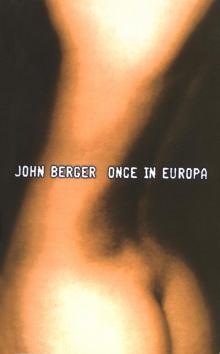 Once in Europa
Once in Europa To the Wedding
To the Wedding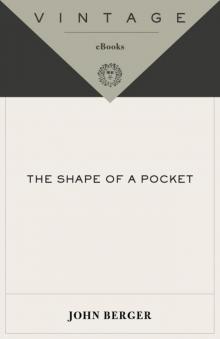 The Shape of a Pocket
The Shape of a Pocket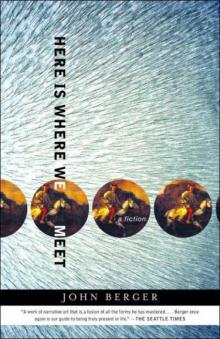 Here Is Where We Meet
Here Is Where We Meet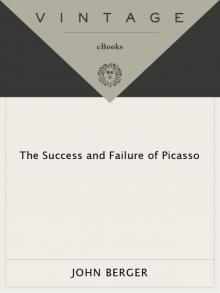 The Success and Failure of Picasso
The Success and Failure of Picasso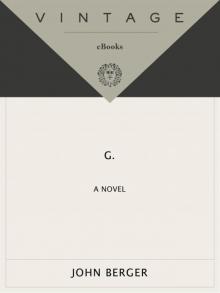 G.
G.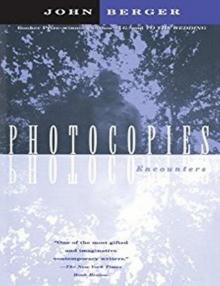 Photocopies: Encounters
Photocopies: Encounters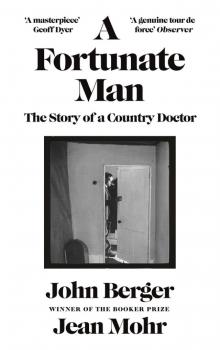 A Fortunate Man: The Story of a Country Doctor
A Fortunate Man: The Story of a Country Doctor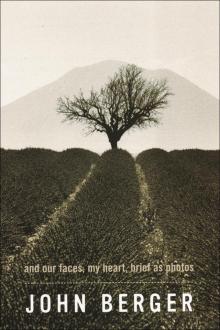 And Our Faces, My Heart, Brief as Photos
And Our Faces, My Heart, Brief as Photos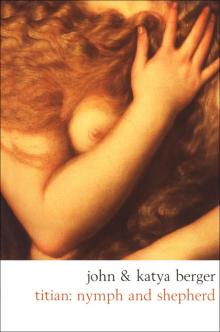 Titian
Titian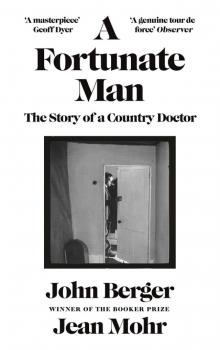 A Fortunate Man
A Fortunate Man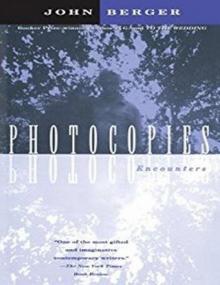 Photocopies: Encounters (Vintage International)
Photocopies: Encounters (Vintage International)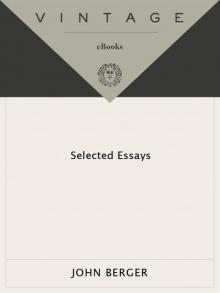 Selected Essays of John Berger
Selected Essays of John Berger